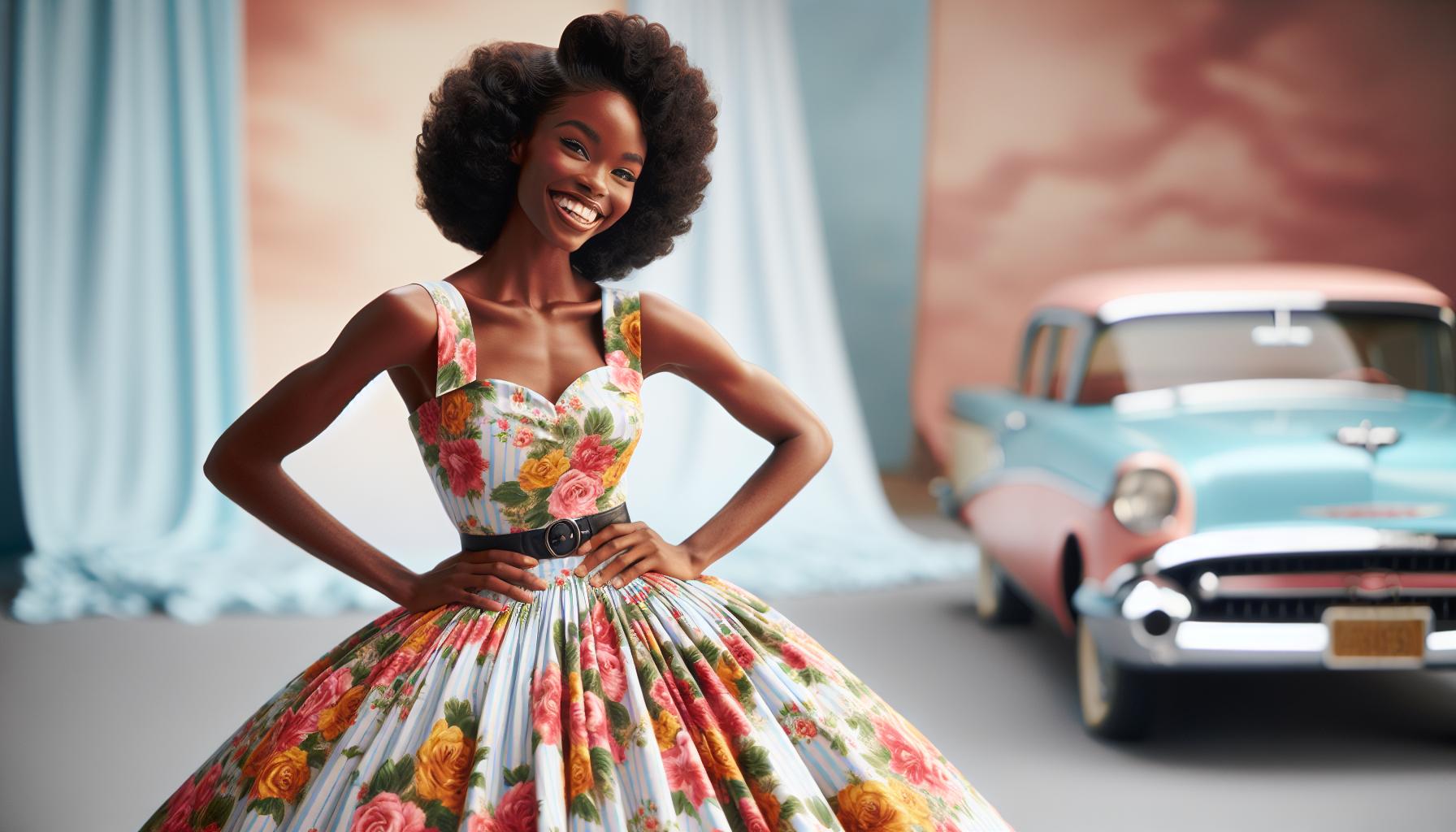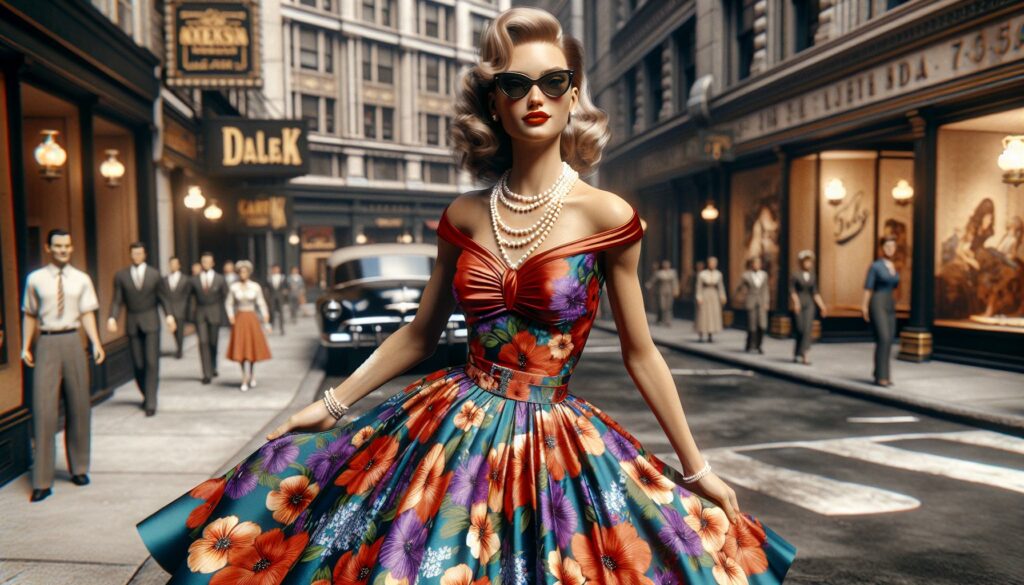Step into a time machine and travel back to the fabulous 1950s, where women’s fashion was a delightful blend of elegance and whimsy. Picture this: full skirts that twirled with every step, fitted bodices that celebrated curves, and bold prints that screamed, “Look at me!” The 50s weren’t just about clothes; they were about making a statement and having a blast while doing it.
From the iconic little black dress to the playful swing dresses, this era redefined femininity. It’s no wonder that today’s fashionistas are digging through their grandmas’ closets for vintage gems. So grab your cat-eye sunglasses and let’s explore the dazzling world of 50s fashion, where every outfit tells a story and every accessory is a conversation starter. Who knew looking fabulous could be so much fun?
Women’s 50s Fashion
Women’s fashion in the 1950s showcased glamour and femininity. The decade favored silhouettes that accentuated the waist, creating an hourglass figure. Full skirts often reached mid-calf, and fitted bodices complemented the overall look. Fabrics featured bold prints and pastel colors, adding vibrancy to daily attire.
Accessories played a crucial role. Women often paired outfits with elegant gloves, pearl necklaces, and cat-eye sunglasses. Shoes, such as kitten heels, became staples that completed ensembles. The emphasis on coordinating elements made outfits more than just clothing; they transformed into expressions of personal style.
Materials varied from cotton for casual wear to luxurious silk for evening gowns. Each type of fabric contributed to the mood of the outfit. Additionally, integrated elements like petticoats under skirts added volume, enhancing the playful vibe of the fashion era.
The cultural context also influenced fashion choices. The post-war era reflected a return to traditional femininity, celebrating domesticity and grace. Hollywood icons, such as Audrey Hepburn and Marilyn Monroe, inspired many women to emulate their styles, further shaping trends in everyday wardrobes.
Fashionable items included swing dresses, tailored suits, and pencil skirts, appealing to a wide range of tastes. Vintage shops today often feature reproductions of these signature pieces, attracting modern fashion enthusiasts seeking nostalgic flair. Emerging interest in retro styles highlights the enduring legacy of 1950s women’s fashion, capturing the attention of new generations.
Key Trends of the 1950s

The 1950s showcased distinctive fashion trends that defined women’s style. Iconic silhouettes and fabrics filled wardrobes of the era, reflecting both glamour and femininity.
Silhouettes and Styles
Classic silhouettes characterized the 1950s, with full skirts and fitted bodices taking center stage. A-line dresses formed a staple for occasions, enhancing the hourglass figure and emphasizing the waist. Pencil skirts offered a more sophisticated option, appropriate for professional settings. Tailored suits emerged, combining elegance with practicality, while swing dresses provided casual yet chic alternatives. Popular items like tea-length dresses, often accented with petticoats, created a playful tone. Each style allowed women to express their personality and embrace their femininity, highlighting the era’s commitment to women’s fashion.
Fabrics and Patterns
The choice of fabrics in the 1950s played a crucial role in shaping these fashionable looks. Cotton and silk became favorites, allowing for diverse styling opportunities. Vibrant prints and pastel colors adorned wardrobes, bringing life to the more subdued post-war climate. Floral patterns dominated casual wear, providing a romantic feel. Geometric designs occasionally surfaced in more modern pieces, balancing tradition with contemporary flair. The use of petticoats added volume to skirts, creating movement and shape. Each fabric contributed to an overall aesthetic that resonated with the optimism of the decade, making 1950s fashion both memorable and influential.
Iconic Figures in Women’s 50s Fashion

The 1950s sparked a unique blend of fashion driven by influential figures and cultural movements. These icons shaped the style landscape of the decade.
Hollywood Influence
Hollywood played a pivotal role in shaping 1950s women’s fashion. Iconic actresses like Audrey Hepburn popularized elegant silhouettes, particularly the little black dress. Marilyn Monroe’s figure-hugging gowns showcased the hourglass silhouette, embedding it in popular culture. Grace Kelly’s refined styles set standards for sophistication with tailored pieces. These stars not only wore their trends; they became them, leading many women to emulate their looks. Films of the era featured these glamorous outfits, reinforcing their popularity. Props such as sunglasses and elegant gloves became must-have accessories, driving a fashion revolution inspired by the silver screen.
Cultural Icons
Cultural icons extended beyond Hollywood, also influencing 1950s women’s fashion. Designers, such as Christian Dior, revolutionized the industry with his “New Look,” emphasizing femininity and elegance. Models like Twiggy later embraced youth-oriented styles, showing the transition in fashion. Additionally, musicians like Billie Holiday and Ella Fitzgerald showcased bold prints and vibrant colors, merging jazz culture with daily wear. The fashion decisions of these figures inspired countless women, establishing a diverse range of styles. Groups like the Beatniks introduced a laid-back approach, utilizing turtlenecks and berets to create a distinctive look. Each icon contributed to an evolving narrative, merging fashion with personal expression and cultural significance.
Accessories and Footwear

Accessories and footwear in the 1950s enhanced women’s outfits, providing charm and personality. Numerous elements defined styles during this playful era.
Popular Accessories
Charming gloves topped many outfits, adding a touch of elegance. Classic pearl necklaces adorned necklines, creating a timeless appeal. Colorful scarves twisted around necks or tied in hair showcased individuality. Iconic cat-eye sunglasses became a staple, offering a bold style statement. Statement brooches pinned to dresses reflected personal flair. Each accessory contributed to a polished, finished look that celebrated femininity.
Shoe Styles
Iconic kitten heels emerged as a favorite, blending comfort and elegance. Women often paired full skirts with classic ballet flats for a chic, easygoing vibe. Pointed-toe pumps made their mark, elevating outfits for more formal occasions. Stylish loafers provided a practical option, allowing versatility in casual wear. Strappy sandals gained popularity in warmer months, enhancing dresses and skirts. Each shoe style offered both functionality and grace, completing the fashionable 1950s silhouette.
The vibrant fashion of the 1950s continues to inspire and captivate. With its emphasis on femininity and playful elegance, this era’s styles remain timeless. Modern fashionistas embrace vintage elements, breathing new life into classic silhouettes and bold prints.
As women explore the charm of 50s fashion, they celebrate not just the clothing but the stories and emotions behind each piece. Accessories and footwear play a crucial role in completing these looks, adding a touch of sophistication and individuality. The legacy of 1950s fashion endures, inviting new generations to discover its beauty and significance.

